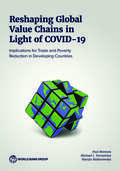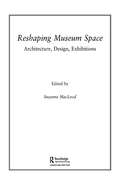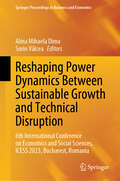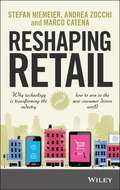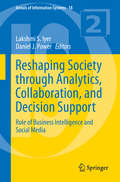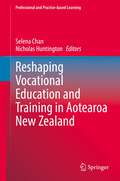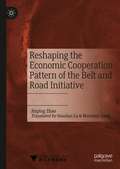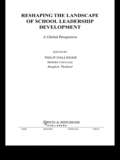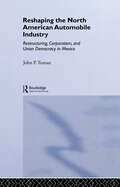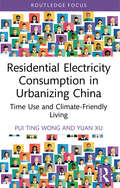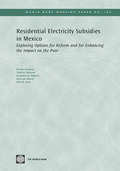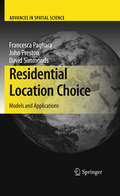- Table View
- List View
Reshaping Global Value Chains in Light of COVID-19: Implications for Trade and Poverty Reduction in Developing Countries
by Paul Brenton Maryla Maliszewska Michael J. FerrantinoGlobal value chains (GVCs) have driven dramatic expansions in trade, productivity, and economic growth in developing countries over the past three decades. Reshaping Global Value Chains in Light of COVID-19: Implications for Trade and Poverty Reduction in Developing Countries examines the economic impact of the COVID-19 (coronavirus) pandemic on GVCs and explores whether they can continue to be a driver of trade and development. The book undertakes the following: • Assesses what the impact of previous crises, such as the global financial crisis of 2008†“09, can say about of the resilience of GVC firms to shocks • Examines what high-frequency data on trade flows can show about the impact of COVID-19 during the sharp global recession of 2020 • Uses discussions with GVC firms to gain a deeper understanding of the impacts of—and their responses to—the COVID-19 shock • Explores simulations from a global economic model to assess the potential longer-term impacts of COVID-19 on low- and middle-income countries and key factors shaping the global economy, including the evolving role of China, the rise of trade restrictions, and policy responses to global warming • Asks what steps countries and international institutions can take to enhance the resilience of GVCs in low-income countries to future shocks. The analysis shows that well-operating GVCs are a source of resilience more than a source of vulnerability. Moreover, steps to maintain and enhance trade contribute to managing a crisis and recovery, while measures to reshore production make all countries worse off. This economic crisis offers countries an opportunity to reshape the global economy into a greener, more resilient, and inclusive system that is better equipped for a changing world. Trade is a powerful tool for achieving this aim.
Reshaping HR: The Role of HR in Organizational Change
by Julie Hodges Mark CrabtreeThe aim of this book is to explore the contribution HR can make to how organizations enact change within the context of an environment of increasing complexity driven by global forces for change. In particular the book focuses on the role of HR in creating value for organizations and engaging stakeholders during transformations. This aim is achieved in several distinct ways. First, a critical perspective is provided of the role of HR in organizational change by examining evidence-based theories, models and frameworks. Second, the book is grounded in empirical evidence from a study conducted by the authors amongst managers and HR professionals across the globe. This provides unique data on the challenges and opportunities which the practice of HR faces within the context of organizational change. Third, consideration is given as to how HR can play an active and constructive role in co-creating sustainable change with managers, employees and other stakeholders. Fourth, the book identifies the capabilities required by HR professionals in order to engage effectively with organizational change. Finally, aware of the dangers of prescriptive lists, the HR practices offered in this book are provided as a basis for amendment, as necessary, by readers depending upon the context of individual organizations. The book will be of value to practising HR professionals as well as students studying HRM and change and development in organizations. Our proposal in this book is that since people are of significant importance to the success of change, and HR knowledge and expertise is vital to the experience and engagement of individuals and teams, internal and external to the organization, there needs to be clarity about the role of HR in transformations. We suggest that HR’s raison d’être is to focus on the people aspect of organizational change and that this needs to be done within the context of improving organizational effectiveness and wellbeing.
Reshaping Markets
by Peer Zumbansen Lomfeld, Bertram and Somma, Alessandro and Zumbansen, Peer Bertram Lomfeld Alessandro SommaSet against the origins and consequences of the global financial crisis, this timely book offers an enriching and revealing narrative of the role that the state plays in regulating markets. Focusing on core areas of private law such as corporate, labour and banking law, the contributors offer a conceptual framework in which to examine the central tenets of the role of private law in today's global economy. In the current climate of ever increasing economic inequality and austerity measures, the authors highlight the urgent need for a comprehensive analysis of the continuing tension between ideas of market liberalism and theories of society. With a focus on both the domestic and transnational dimensions of market governance, the authors offer a crucial insight into the co-existence and interaction between state and market-based economic governance.
Reshaping Museum Space: Architecture, Design, Exhibitions (Museum Meanings)
by Suzanne MacLeodReshaping Museum Space pulls together the views of an international group of museum professionals, architects, designers and academics highlights the complexity, significance and malleability of museum space, and provides reflections upon recent developments in museum architecture and exhibition design. Various chapters concentrate on the process of architectural and spatial reshaping, and the problems of navigating the often contradictory agendas and aspirations of the broad range of professionals and stakeholders involved in any new project. Contributors review recent new build, expansion and exhibition projects questioning the types of museum space required at the beginning of the twenty-first century and highlighting a range of possibilities for creative museum design. Essential reading for anyone involved in creating, designing and project managing the development of museum exhibits, and vital reading for students of the discipline.
Reshaping Power Dynamics Between Sustainable Growth and Technical Disruption: 6th International Conference on Economics and Social Sciences, ICESS 2023, Bucharest, Romania (Springer Proceedings in Business and Economics)
by Alina Mihaela Dima Sorin VâlceaThis book covers various topics related to economics and the social sciences, such as artificial intelligence, sustainability, ESG, and tax administration. The respective contributions provide insights and perspectives on the current challenges and opportunities in these fields, while also showcasing the latest research and innovations from scholars and practitioners around the world. The book is based on the papers presented at the 6th International Conference on Economics and Social Sciences, ICESS 2023, which was held in Bucharest, Romania.
Reshaping Retail: Why Technology is Transforming the Industry and How to Win in the New Consumer Driven World
by Andrea Zocchi Stefan Niemeier Marco CatenaThe modern retail system has worked to dazzling effect. From the 19th century, store owners emerged from small beginnings to set in train an industry that has seen some operators become nationally, even globally, dominant. Along the way, they turned retailing into an art, and then a science. Now retailers in emerging markets appear to be repeating the story all over again, except on a scale and at a speed beyond anything we have seen before. Given all of this, it can be hard for those who work in retailing to accept that the industry as we know it is living on borrowed time, on the brink of transformation. There is now an urgency with which conventional store-based retailers must now act and the extent of the challenges this change represents in strategic, organizational, and above all, technological terms. Reshaping Retail sets out the driving causes, current trends and consequences of a transformation in retail triggered by technology. The changes go far beyond making items available for sale on the internet. Starting by briefly setting the historical and business system contexts for retail and describe the role that technology has played in the creation of modern retail it then explains the underlying technological drivers behind the current revolution – radical changes in the capacity of both hardware and software, mobile telecommunications changes and the advances of the Internet. Ultimately, success will hinge on more than competence; it will come down to a way of thinking. Customer-centricity will need to be valued not just by the store owner, as in the past, but also by all employees in the organization. It will need to become embedded in their daily tasks. The same applies to technology, which must be at the center of the organization and recognized as such by everyone. With a combination of extensive desk and field research, interviews with leading retailers and technologists, together with the real world experience of practitioners in this area, Reshaping Retail will inspire and help store retailers to make the necessary transformation now to win in the new consumer driven world.
Reshaping Society through Analytics, Collaboration, and Decision Support
by Daniel J. Power Lakshmi S. IyerThis volume explores emerging research and pedagogy in analytics, collaboration, and decision support with an emphasis on business intelligence and social media. In general, the chapters help understand where technology involvement in human decisions is headed. Reading the chapters can help understand the opportunities and threats associated with the use of information technology in decision making. Computing and information technologies are reshaping our global society, but they can potentially reshape it in negative as well as positive ways. Analytics, collaboration and computerized decision support are powerful decision aiding and decision making tools that have enormous potential to impact crisis decision making, regulation of financial systems, healthcare decision making and many more important decision domains. Many information technologies can potentially support, assist and even decide for human decision makers. Despite the potential, some researchers think that we know the answers to how these technologies will change society. The "Wisdom of Crowds" or "Big Data" become the topic of the day and are soon replaced with new marketing terms. In many ways, mobile technology is just another form factor to adapt decision support capabilities too and experiment with new capabilities. The cloud is a nebulous metaphor that adds to the mystery of information technology. Wireless technology enables the ubiquitous presence of analytics and decision support. With new networking capabilities, collaboration is possible anywhere and everywhere using voice, video and text. Documents can be widely shared and massive numbers of documents can be carried on a small tablet computer. Recent developments in technologies impact the processes organizations use to make decisions. In addition, academics are looking for ways to enhance their pedagogy to train students to be more adept in understanding how emerging technology will be used effectively for decision making in organizations. The chapters are based on papers originally reviewed at the Special Interest Group on Decision Support Systems (SIGDSS) Workshop at the 2013 International Conference on Information Systems (ICIS 2013). Ultimately this volume endeavors to find a balance between systematizing what we know, so we can teach our findings from prior research better, and stimulating excitement to move the field in new directions.
Reshaping Society through Analytics, Collaboration, and Decision Support: Role of Business Intelligence and Social Media (Annals of Information Systems #18)
by Daniel J. Power Lakshmi S. IyerThis volume explores emerging research and pedagogy in analytics, collaboration, and decision support with an emphasis on business intelligence and social media. In general, the chapters help understand where technology involvement in human decisions is headed. Reading the chapters can help understand the opportunities and threats associated with the use of information technology in decision making. Computing and information technologies are reshaping our global society, but they can potentially reshape it in negative as well as positive ways. Analytics, collaboration and computerized decision support are powerful decision aiding and decision making tools that have enormous potential to impact crisis decision making, regulation of financial systems, healthcare decision making and many more important decision domains.Many information technologies can potentially support, assist and even decide for human decision makers. Despite the potential, some researchers think that we know the answers to how these technologies will change society. The "Wisdom of Crowds" or "Big Data" become the topic of the day and are soon replaced with new marketing terms. In many ways, mobile technology is just another form factor to adapt decision support capabilities too and experiment with new capabilities. The cloud is a nebulous metaphor that adds to the mystery of information technology. Wireless technology enables the ubiquitous presence of analytics and decision support. With new networking capabilities, collaboration is possible anywhere and everywhere using voice, video and text. Documents can be widely shared and massive numbers of documents can be carried on a small tablet computer. Recent developments in technologies impact the processes organizations use to make decisions. In addition, academics are looking for ways to enhance their pedagogy to train students to be more adept in understanding how emerging technology will be used effectively for decision making in organizations.The chapters are based on papers originally reviewed at the Special Interest Group on Decision Support Systems (SIGDSS) Workshop at the 2013 International Conference on Information Systems (ICIS 2013). Ultimately this volume endeavors to find a balance between systematizing what we know, so we can teach our findings from prior research better, and stimulating excitement to move the field in new directions.
Reshaping Vocational Education and Training in Aotearoa New Zealand (Professional and Practice-based Learning #34)
by Selena Chan Nicholas HuntingtonThis book contributes extensively to a better understanding of how vocational education and training (VET) and practice-based learning and teaching is developed and designed. It presents examples of vocational education as an ongoing dialogue, continually refreshed through engagement between educators and learners, Māori, employers, industry, and others. It demonstrates how the needs of learners can be met through relevant models of delivery, and how organisations and individuals work towards equity of access and parity of outcomes for all.It details the origins, purposes and evolution of vocational organisations, initiatives supporting Māori and Pasifika success and women in traditionally male-dominated occupations, the roles, provisioning and impact of foundation VET across different contexts, innovations through Certificate, Diploma and Degree programmes of learning, the contribution of new technologies to learning approaches, and the efficacy of education and professional development for VET teachers.This collection of chapters illustrates how Aotearoa New Zealand’s VET system is responding to challenging and changing environments through new frameworks of practice, approaches, and models of delivery. As an overview of a system in change, it is of interest to VET educators, system managers, and policy makers.
Reshaping the Asia Pacific Economic Order (PAFTAD (Pacific Trade and Development Conference Series))
by Christopher Findlay Hadi SoesastroRelationships and alignments among the nations of the world’s most populous and productive region, the Asia Pacific, are in flux. Current global political, economic and security uncertainty, heightened by 9/11 and the subsequent War on Terror, has fuelled a reassessment by many Asia Pacific nations about the structure and form of future economic and political cooperation and development. Featuring contributions from some of the most eminent and influential economists and political scientists in the Asia Pacific region, this book explores the forces reshaping the Asia Pacific economic order, and where these changes may lead. Focusing on the origins of the shift towards policy driven integration, the book examines what new structures may eventually emerge on both sides of the Pacific, the ways in which this shift will affect the progress of economic integration and how cross-Pacific relations will therefore be affected.
Reshaping the Economic Cooperation Pattern of the Belt and Road Initiative
by Jinping ZhaoThis book focuses on the important theme of economic cooperation along the Belt and Road. Starting from an analysis of current situation, the book defines the cooperation direction and specific tasks for extensive fields and goes on to provide a systematic analysis of the cooperation mechanism, trade, investment, infrastructure construction, energy and industry park cooperation along the Belt and Road. Using in-depth research on the situation, opportunities and challenges in pushing forward the economic cooperation along the Belt and Road, the author puts forward policy suggestions on the way forward.
Reshaping the Landscape of School Leadership Development: A Global Perspective (Contexts Of Learning Ser.)
by Philip HallingerReshaping the Landscape of School Leadership Development: A Global Perspective traces developments in this arena as they evolved since 1980. The book is comprised of chapters authored by the leading scholars in the fields of educational leadership and school leadership development from the United States, Canada, Europe, Asia, and Australia. The vol
Reshaping the North American Automobile Industry: Restructuring, Corporatism and Union Democracy in Mexico (Routledge Studies in Employment and Work Relations in Context)
by John P. TumanThis work examines the responses of unions and workers to regional integration and restructuring in the automobile industry in North and Central America. The focus is on the automobile industry in Mexico, which, because of its size and importance, is viewed as a strategic sector of the Mexican economy and was the focal point of talks between the US, Canada and Mexico during negotiations on NAFTA. Focusing on the period from 1980, John P. Tuman examines the changes implemented by firms to promote export production, he explores reasons for the variation in labour responses to restructuring, and he discusses the prospects for cross-border organizing and co-operation among automobile workers in Canada, the US and Mexico.
Reshore Production Now: How to Rebuild Manufacturing and Restore High Wages, High Profits, and National Prosperity in the USA
by William A. LevinsonThis book addresses the vital importance of reshoring US manufacturing capability to ensure economic and military security and then discusses the proven methods that the United States used to gain manufacturing supremacy in the first place. The vital takeaway is: If the job can be made sufficiently productive, the per-unit labor cost ceases to be relevant which means a business can pay high wages, realize high profits, and deliver low prices simultaneously. The contest is then not between high wages and cheap labor, but between efficiency and inefficiency and, when automation is involved, machine against machine. Readers will be able to put these principles to work very quickly to achieve tangible results. The relatively low Federal minimum wage has meanwhile become a major issue, but inflation skyrocketed in the second quarter of 2022 when higher wages, and higher demand for goods and services, were not matched with higher productivity. The book addresses the relationship between the money supply and the velocity of money to prices, wages, and productivity. A manufacturing resurgence in the United States will not only increase our standard of living enormously but generate taxable economic activity that will help pay down rather than increase the Federal debt. Higher productivity also delivers a greater supply of goods to accompany higher wages, and thus works against inflation. This can prevent looming recessions and disruptions.
Residencial Los Andes
by Nicolas P. Retsinas Lisa StropePeninsula Investment Group is deciding wether or not to recapitalize an equity investment in a Residencial Los Andes, a residential project in Santiago, Chile, or take a substantial loss. The project did not met its sales goals and the bank pressured the investors to liquidate the construction loan. Early on, Peninsula had identified Chile a target market, however, in investing in Residencial Los Andes, it had made several exceptions to it's investment strategy. The case addresses what went wrong in the evolution of the project, what measures need to be taken if Peninsula did increase it's capital committment.
Resident Duty Hours: Enhancing Sleep, Supervision, and Safety
by Committee on Optimizing Graduate Medical Trainee (Resident) Hours Work Schedules to Improve Patient SafetyMedical residency in the United States aims to prepare recent medical school graduates to practice medicine independently. One fundamental requirement of resident education is in-depth, firsthand experience caring for patients. During the three to seven years of training, residents often work long hours with limited time off to catch up on their sleep. They can experience fatigue on the job, contributing to increased errors and accidents. However, many medical educators believe extensive duty hours are essential to provide residents with the educational experiences they need to become competent in diagnosing and treating patients. Resident Duty Hours: Enhancing Sleep, Supervision, and Safety, a December 2008 report from the IOM, asserts that revisions to medical residents' workloads and duty hours are necessary to better protect patients against fatigue-related errors and to enhance the learning environment for doctors in training. The report recommends that residency programs provide regular opportunities for sleep each day and each week during resident training. In addition, it recommends that the Accreditation Council for Graduate Medical Education provide better monitoring of duty hour limits and that residency review committees set guidelines for residents' patient caseload. Patient handover procedures and supervision of residents should also be strengthened. Until these changes take place, residency programs are not providing what the next generation of doctors or their patients deserve.
Residential Care Services for the Elderly: Business Guide for Home-Based Eldercare
by Doris K WilliamsAs the elderly population continues to increase, the need for suitable housing will continue to rise as well. This handbook is designed to help individuals and families determine the feasibility of starting a small home business providing residential home services for one or more elderly persons. Persons interested in starting a business of this type will find this unique book a goldmine of important information. Residential Care Services for the Elderly is a valuable decision-making tool which helps readers determine if this type of business venture is appropriate and, if so, how to start and maintain a residential care service for the elderly. Thorough coverage of background and implementation details provides potential operators with a rationale and necessary information. Numerous self-assessment and resource inventories in this practical handbook will guide readers in determining their areas of interests and competencies. Opportunities for networking among state licensing/standards agencies, funding agencies, and a listing of elder care organizations and advocacy groups adds value to this time-saving resource, ensuring a quicker and more likely success. Case studies, detailed guides, and the discussion of positive and negative aspects of being the owner of a small residential care business, based on interviews with people currently running elder care residential services, are also included. All aspects of business operations are covered in Residential Care Services for the Elderly, including sources of funding and potential incomes; emotional and financial cost/benefit factors; parameters of organizing the business including personnel, respite care workers, need for registered nurses, and food service; special needs of clients; details of financial plans with outlines and sample forms; and variables of success and failure. Graduate and undergraduate students taking classes in regard to gerontological business and long-term care related alternatives will also find this statistic-filled handbook a useful reference.
Residential Carpentry: Student Guide Level 2
by Nccer StaffThe material in this textbook will help you prepare for a career in residential carpentry.
Residential Electricity Consumption in Urbanizing China: Time Use and Climate-Friendly Living (Routledge Focus on Energy Studies)
by Yuan Xu Pui Ting WongThis book forges a link between residential CO2 emissions and time use, focussing on China as a key case study. To provide a better understanding of the energy implications of the lifestyle differences between urban and rural China, Pui Ting Wong and Yuan Xu utilise time-use methodology as an alternative way to explore the links between individual lifestyle and residential electricity consumption. They begin by examining how Chinese citizens divide their time between daily activities, highlighting patterns around indicators including age, gender, education, and economic status. They go on to quantify CO2 intensities of these time-use activities. Through this linkage, this book presents an alternative strategy for climate-friendly living, highlighting the ways in which urban planning can be deployed to help individuals adapt their time-use patterns for CO2 mitigation. Providing a novel contribution to the growing literature on residential electricity consumption, Residential Electricity Consumption in Urbanizing China will be of great interest to scholars of climate policy, energy studies, time use, and urban planning.
Residential Electricity Subsidies in Mexico
by Todd M. Johnson Kristin Komives John R. Scott Jonathan D. Halpern Jose Luis AburtoLarge and growing subsidies to residential consumers in Mexico have become a major policy concern. This report explains the growth of subsidies, the current distribution of subsidies across income classes, and uses utility and household survey data to simulate how alternative subsidy mechanisms could improve distributional and fiscal performance. The goal is to help inform discussion in Mexico about how to reduce subsidies and redirect them toward the poor. The findings also offer lessons for other countries that are planning tariff reforms in their electricity sectors.
Residential Institutions in Britain, 1725–1970: Inmates and Environments (Perspectives in Economic and Social History #27)
by Jane HamlettThe essays in this collection explore both organizational intentions and inhabitants' experiences in a diverse range of British residential institutions during a period when such provision was dramatically increasing.
Residential Leaseholders Handbook
by Charles WardThe Residential Leaseholders’ Handbook explains in plain language everything leaseholders and their advisers need to know in relation to long residential leases. Among the common problems it tackles are absent landlords; spiralling service charges; the right to be consulted on significant or long term service charge items; how to challenge excessive charges; how to gain control from difficult or exploitive landlords and how to set up a management company. The book begins with the legal framework of a typical ground lease and its main provisions including: responsibility for repairs, insurance and management of a building, the meaning of the covenant for "quiet enjoyment" and the termination of a lease due to overdue rent. The author explains what lenders look for in a residential lease; how leaseholders can insist that their lease is amended to meet lenders’ requirements and the issues relating to assignment, subletting and alteration of leasehold premises.Extensive use of real life scenarios, landmark cases and some fictitious case studies illustrate how leasehold law works in practice and enables readers to effectively assess their position. Written in non-technical language this book is a reliable source for leasehold management companies, managing agents, legal advisers, students and residential leaseholders.
Residential Location Choice: Models and Applications
by John Preston David Simmonds Francesca PagliaraThe effective planning of residential location choices is one of the great challenges of contemporary societies and requires forecasting capabilities and the consideration of complex interdependencies which can only be handled by complex computer models. This book presents a range of approaches used to model residential locations within the context of developing land-use and transport models. These approaches illustrate the range of choices that modellers have to make in order to represent residential choice behaviour. The models presented in this book represent the state-of-the-art and are valuable both as key building blocks for general urban models, and as representative examples of complexity science.
